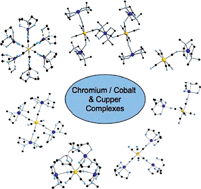Numerous μ-cyanido bridged polynuclear complexes, [M(CN)n(CNCuIIL)6−n]m+ (with M = CrIII or CoIII, n = 0–5 and L = tris(2-amino)ethylamine (tren) or N,N-dimethylethylenediamine (Me2en)), have been synthesised: [CoIII(CN)5{CNCuII(Me2en)2}]−, [CoIII(CN)4(CNCuIItren)2]+/[CoIII(CN)3(CNCuIItren)3]3+, [{CoIII(CN)6}2{CuII(Me2en)2}5]4+ and [CoIII(CNCuIItren)6]9+ denoted correspondingly CoCu, CoCu2/CoCu3, Co2Cu5 and CoCu6 as well as chromium derivatives: [CrIII(CN)5{CNCuII(Me2en)2}]−, cis-[CrIII(CN)2{CNCuII(Me2en)2}4]5+, trans-[CrIII(CN)2{CNCuII(Me2en)2}4]5+ and [CrIII(CNCuIItren)6]9+ denoted CrCu, ciscisciscisciscis-CrCu4, transtranstranstranstrans-CrCu4 and CrCu6, respectively. All compounds have been characterised by IR spectroscopy and most of them by X-ray crystallography. The magnetic properties of the complexes have been studied and the spin and the anisotropy values as well as the intra- and inter-molecular exchange couplings evaluated. For the cobalt centred species, in first approximation, the complexes behave as one, five and six isolated copper(II) complexes, but more accurate studies allow us to evaluate the weak antiferromagnetic coupling constant between two next-nearest neighbours Cu–Co(III)–Cu. For the chromium centred species, the spin state varies from 1 to 9/2 (with ferromagnetic interaction for transtranstranstranstrans-CrCu4 and CrCu6 and weak antiferromagnetic interaction for CrCu and ciscisciscisciscis-CrCu4) with a negligible effective anisotropic factor. Experimentally, the exchange coupling between the μ-cyanido bridged spin carriers Cr(III) and Cu(II) varies from −2.5 to +45 cm−1 increasing with the C–N–Cu angle. A magneto–structural correlation allows us to rationalise the most relevant features of the exchange interaction between Cr(III) and Cu(II) through a cyanido bridge.


 Please wait while we load your content...
Please wait while we load your content...